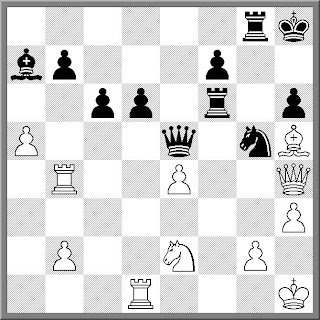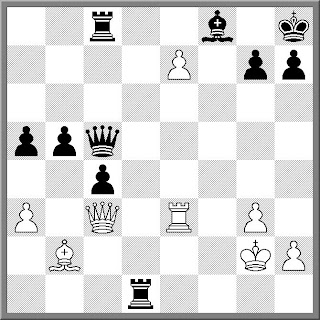

The former Soviet champion Alexander Beliavsky scored a memorable victory in the Tilburg 1981 international tournament. The field comprised most of the world's elite, including future world champion Garry Kasparov as well as the former champions Boris Spassky and Tigran Petrosian. In fact, the only leading players who were not present at Tilburg were Anatoly Karpov and Viktor Korchnoi. They were otherwise occupied in a world title match in Italy.
No one wins a tournament of this calibre without some luck. In particular Beliavsky had to survive a mutual time scramble in his game with Ljubomir Ljubojevic before finally achieving a draw. Curiously, Beliavsky's annotations to this game in Informant 32 leave a few unanswered questions. Today we will look at the exciting conclusion of this game, supplementing Beliavsky's annotations with a few extracts from my notebook.
In the first diagrammed position, the time control at move 40 is looming, and things are complicated. Beliavsky as Black has just played 35...Rf6, threatening 36...Bf2. Ljubojevic correctly decides to bail out by offering the exchange of queens.
36.Qg3 Qxg3 37.Nxg3 Nxh3!?
A clever psychological blow. Whenever the opponent puts a piece en prise, it is natural to believe that taking it must be wrong...
38.Rf1?
White is defending comfortably after 38.gxh3 Rxg3 39.Bg4! Rf2 40.Rxb7 Bc5 41.b4! and now Black has nothing better than 41...Rgg2 and a draw by repetition (Beliavsky).
38...Nf2+ 39.Kh2 (second diagram) 39...d5?
Beliavsky gave 39...Rf4! (threatening 40.Rxb7 Rh4+ 41.Kg1 Nh3+and wins) 40.Nf5 Rg5 41.Bxf7(?) and now 41...Rgxf5 wins immediately since the bishop is also attacked. However, White can defend more stubbornly with 41.Be2! Rgxf5 42.g3! Rg4!? 43.Kg2 Rxa5 44.Rxf2! Rgg5 45.Rxf7 although Black still has the advantage after 45...b5.
More convincing is 39...Rg5! If 40.Rxb7 then 40...Bd4 intending 41...Be5, while if 40.Be2 then 40...Rfg6, with a decisive attack on White's knight in both cases.
Beliavsky gave 39...d5 the question mark. But it might deserve two because it does more than throw away the win.
40.Rxb7?
Fate has given Ljubojevic a chance of his own. He can win the exchange with 40.e5! since the attacked rook is short of squares. Black can recover the material with a counterattack: 40...Bb8! 41.exf6 Ne4 42.Bxf7 Rg4 but after 43.Rxb7 Rh4+ 44.Kg1 Bxg3 45.Rf3 Bh2+ 46.Kf1 Nd2+ 47.Ke2 Nxf3 48.gxf3 White's a-pawn is extremely dangerous and should cost Black the game.
40...Bd4?
The final mistake, after which the game peters out to a draw. Beliavsky gave 40...Bc5 41.Rxf7 Rxf7 42.Bxf7 Rg7 43.exd5 Bd6 44.Be6 Bxg3+ 45.Kg1 cxd5 46.Rxf2 Bxf2+ 47.Kxf2 Rb7 with a slight edge to Black, but for some he reason he failed to notice the defensive shot 40...Bb8!, winning material. White is practically forced to play 41.Rxb8 Rxb8 42.exd5 cxd5 43.a6 Rxb2 and can make things difficult with the further 44.Ra1 Rb8 45.a7 but it is hard to believe that Black is not winning after 45...Ra8.
After the text move 40...Bd4, Ljubojevic played the simple
41.Rxf7
forcing off a pair of rooks. The game ended in a draw a few moves later.

